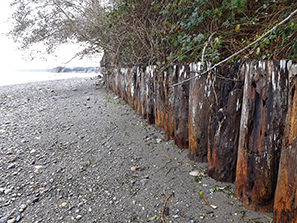 Bulkheads, seawalls, and riprap are some of the words that describe man-made structures meant to hold back the erosion caused by waves, wind, and tides. This armoring also includes boat ramps, piers, docks, and any other structure on the beach. Such structures contribute to the armoring or hardening of the shorelines of Puget Sound. It is estimated that more than a quarter of Puget Sound shorelines are currently armored.
Bulkheads, seawalls, and riprap are some of the words that describe man-made structures meant to hold back the erosion caused by waves, wind, and tides. This armoring also includes boat ramps, piers, docks, and any other structure on the beach. Such structures contribute to the armoring or hardening of the shorelines of Puget Sound. It is estimated that more than a quarter of Puget Sound shorelines are currently armored.
While armoring may serve to protect the bluff against wave erosion, the energy of the waves may be diverted elsewhere, often toward the bottom of the bulkhead. This water movement scoops away sand and may eventually cause the bulkhead to be undermined and lean towards the water. In all cases, however, the wave energy is also directed back towards the beach, scouring away the sand and small gravel, leaving larger gravel and sometimes bedrock in place of the once sandy beach. When several homes or a community have hundreds of feet of bulkhead along the beach, this effect may be more dramatic. The finer sand and gravel may end up being moved from in front of the bulkheads to sites at one or the other end of the bulkheads, due to littoral drift. If the beach was a location where fish like surf smelt or sand lance deposited their eggs, the change of sand and gravel compositions could cause the beach to no longer be a reliable spawning location for these important forage fish. Salmon, seabirds, and many other marine species depend on such forage fish in their diet. Likewise, the change in a beach’s characteristics could mean the end of its ability to support the important habitat provided by eelgrass beds, which are nature’s nurseries for a wide range of marine species. Over the past century there have been significant reductions in the size and number of eelgrass beds in Puget Sound.
Without armoring, long term erosion is generally quite slow, often less than one foot per decade. Some locations of Puget Sound that experience more dynamic wave action have higher erosion rates. Erosion usually does not occur at a constant rate so it is hard to predict erosion patterns. You could experience little erosion of your property for 40 years, and then a landslide removes a large piece of your bluff at one time. Sometimes these landslides are not caused by erosion from wave action, but due to heavy rains, which cause heavy super-saturated soils.